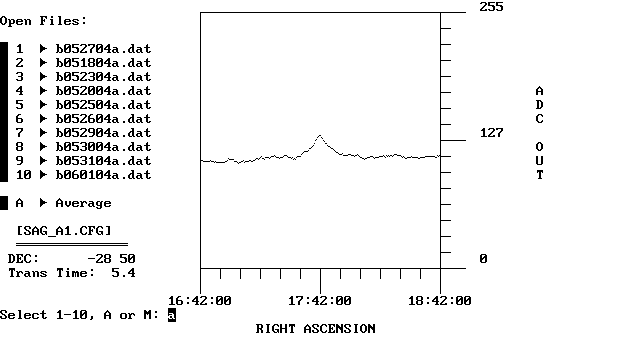
|
|
Last Update: November 23rd, 2013
BAMBI-A (California) is currently down due to a fault in its front-end downconverter section. BAMBI-B (Colorado) is currently down due to
its 10-foot dish antenna being destroyed in a snowstorm.
July 30th, 2005
June 12th, 2004
Re-observations of SAG A, the center of our galaxy, were successful using the new 12 foot dish for BAMBI-A! Below is a plot showing the average of 10 scan nights, with SAG A revealed as a gaussian deflection centered at 17:42:00 RA, -28 50 DEC:

This observation verifies that BAMBI-A's new antenna can see declinations
as far south in the sky as -28 50 degrees, which is near the southern horizon
from this location. Re-observations of CYG A and TAU A conducted earlier
were also successful with the new dish.
September 7th, 2003
Here is a photo of BAMBI-A's new 12 foot KTI dish, which has now replaced its original 8.5 foot dish. Due to its size, a total of 2,400 pounds of concrete was needed to securely anchor it:
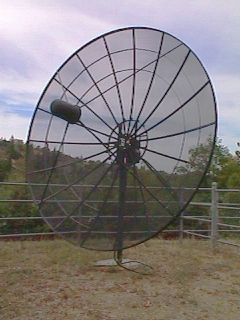
August 31st, 2003
Re-observations of the CASS-A supernova remnant were successful using the new 12 foot dish for BAMBI-A!!! Below is a plot showing the average of 10 scan nights, with CASS A revealed as a gaussian deflection centered at 23:22:00 RA, +58 43 DEC:
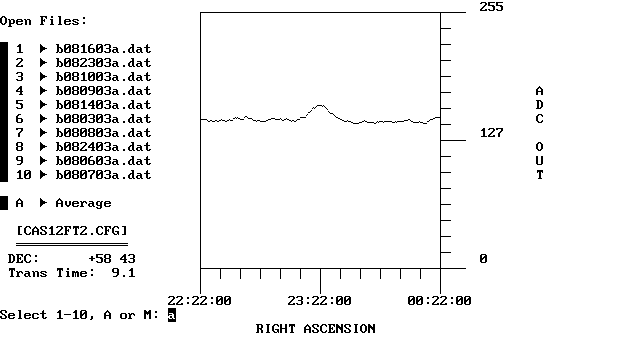
Note that CASS A when viewed with the new 12 foot dish appears less
spread out due to the narrower half-power beam width (1.2 degrees) versus
the old 8.5 foot dish which had a HPBW of 1.9 degrees. This also shortens
the transit time for sources through the beam, and therefore "sharpens"
the image.
August 7th, 2003
BAMBI-A (in California) has just been upgraded to a 12 foot diameter KTI CKD-12 dish antenna, from it's original 8.5 foot Orbitron dish. This antenna has twice the collecting area of the old one, increasing our signal-to-noise ratio for SETI work, as well as raising our spatial resolution due to the narrower beam width (approximately 1.2 degrees at 4 GHz). The new PROFORM H-180 horizon-to-horizon motorized declination drive has been aligned to move in a north-south arc as before, except we have chosen an arc that includes both the North Star the GALAXY-5 C-BAND satellite at -125 degrees West longitude. We will now use GALAXY-5 instead of the aging ANIK-E2 as a test beacon for the systems. All GALAXY-5 transponders are coming in "loud and clear" using the 810A spectrum analyzer on both vertical and horizontal polarizations. Re-observations of the CASS-A supernova remnant are now underway to fine tune the RA and DEC alignment using this precisely known natural source.
BAMBI-B (in Colorado) is going to be upgraded to a 12 foot dish soon,
as it's 10 foot antenna suffered structural damage due to the blizzard
this past winter.
November 25th, 2002
Mike F. has written a number of additional essays
of interest to amateur radio astronomers, including an overview and orientation
to the interstellar medium
(esp. hydrogen gas and molecular clouds), electromagnetic
waves (esp. polarization), elliptical
orbits (esp. planetary radio astronomy), and the standard
model. He has also updated his previous notes about noise
temperature.
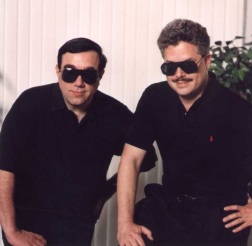
Mike F. and Bob Lash sporting the latest in Project BAMBI fashion.
November 19th, 2001
Mike F. has prepared this essay
about SETI in general, as well as the BAMBI search strategy. In addition,
he has put together some thoughts on the topic of noise
temperature in radio astronomy.
March 20th, 2000
Printed circuit board layouts for many of the BAMBI schematics are here
for download, thanks to John Perterson! (PC Board packages are in ZIP
format, and include Gerber files, Eagle PCB files, and .JPG images).
May 26th, 1999
Another milestone... BAMBI-B completes it's first space signal test! It sucessfully detected the ANIK-E2 geosynchronous satellite, and you can see the actual power profile (at 1 Hz resolution) being displayed on the computer screen to the right of Mike F. in the photo below.
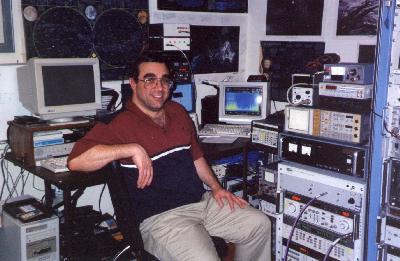
This is the "Antenna Complex" at BAMBI site B in Colorado. The 10 foot
antenna on the left is the radio telescope (and the other antenna is for
TVRO, but looks cool to have it in this picture too, don't you think?).
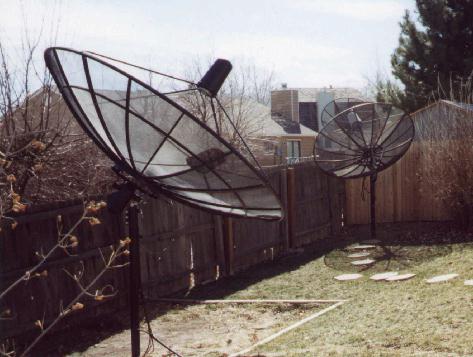
| Entrance to theBAMBI-B Lab... | BAMBI-B in its full glory! Note optional flight helmet... |
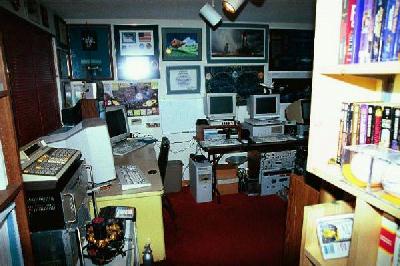 |
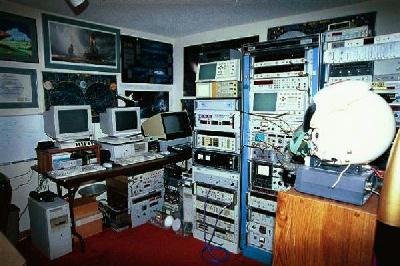 |
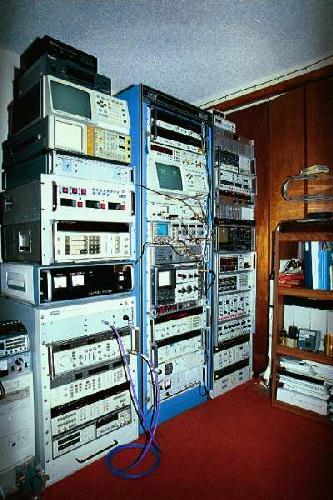 |
This is the RF section of BAMBI-B, along with additional microwave
test equipment. Special thanks to the Western Test
Company for their generous donations of much of this equipment!
Can you spot what's been added since the last update? Hint: It's sleek
and has square meters. Give up? Answer: It's a GOES satellite receiver...
why? Looks cool, that's why... :-).
|
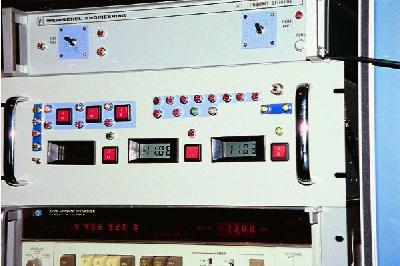 |
BAMBI-B Analog-to-digital converter and 128KHz lowpass filer have been moved to a new and improved home. The same conversion from stand-alone boxes to rack-mount is being planned for BAMBI-A. |
October 19th, 1998
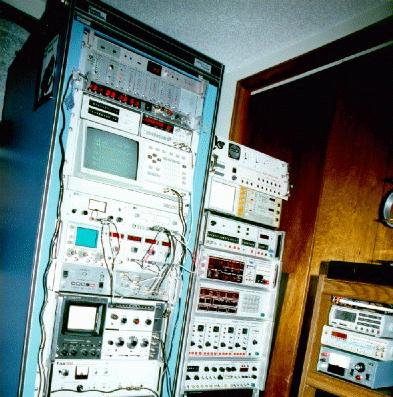 Photo: The BAMBI
Site-B Equipment Rack (photo by Mike F.).
Photo: The BAMBI
Site-B Equipment Rack (photo by Mike F.).
Construction of the BAMBI Site-B system by Mike F. has been completed,
and testing work is now underway.
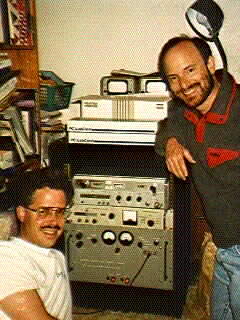 Photo: The BAMBI Site-A Varian V-4700A Rubidium Atomic Frequency Standard,
and two of it's admirers (Bob Lash and Mike Fremont).
Photo: The BAMBI Site-A Varian V-4700A Rubidium Atomic Frequency Standard,
and two of it's admirers (Bob Lash and Mike Fremont).
January 7th, 1998
Construction of the dual 256K buffer card for BAMBI-A has been completed. This was built on a PCL-750 IBM-PC/AT protoboard, and allows the continuous sampling of data for running the 256K FFT at one second intervals. The card alternates between a pair of 256K banks, so that while one is filling, the other is read by the PC.
August 2nd, 1997
Upgrades for our 3.1 million channel survey continue. Because objects remain between the half-power points of the antenna beam for at least 8 minutes (at 0 degrees declination, longer at other declinations), running a 256K FFT at one second intervals will allow us to assay 3.1 million channels at a depth of 20 seconds per channel. This corresponds to obtaining 20 consecutive one-second spectral registers of 131,072 channels at 1 Hz per channel, and then stepping the 810A as a digitally controlled tuner to the next "block" every 20 seconds for 8 minutes. (1 twenty second block X 131,072 channels/block X 3 blocks/min X 8 min = 3,145,728 channels searched 20 seconds deep at 1 second intervals for drifting CW).
Our two new Pentium-Pro 200 Dual Processor machines have arrived (with one CPU installed in each for now), and Linux 2.0.27 was installed this week (the 2.0.30 Linux kernel in the Slackware 3.3 distribution turned out to be unstable, so we downgraded to 2.0.27). Both systems can now automatically connect to the Internet and communicate between Site-A and Site-B via an FTP perl script.
We also obtained the two IRIG-B (Datum 9100 series) Time Code Generators
this week. These surplus units may be somewhat old, but they work fine
and are certainly well "burned in". :)
July 9th, 1997
BIG NEWS! Takuya Ooura in Tokyo has developed a fast, highly efficient FFT package which can run a 256K complex floating point FFT on a Pentium Pro 200 in 0.4 seconds (we were able to speed it up to this point by converting the double float variable types to single floats). It is written in C, and compiles fine under gcc 2.6.3 on a Linux system. Due to this incredible jump in speed in software FFT processing and the rapid advance in PC processor power, we have decided to switch our plans from using the IQMAC FFT chip set to doing this directly in software. The plan is to put together a pair of dual processor Pentium Pro 200 systems running Linux to do the 256K FFT's and CW detection. These in turn will be tied to the original P-133 computers via PC-NFS LAN.
To more fully document interesting potential detections, we have decided to add a pair of VHS video recorders to both sites. This is in addition to the digital records we will be generating. These units will continuously record the raw analog signals on the video track, and will simultaneously record an encoded IRIG-B time code using the audio track locked to the rubidium atomic clocks. The reason for dual recorders is to allow for continuous recording. One recorder can rewind as the other records. The tapes will normally get re-recorded over, unless an interesting event was found real-time warranting the tape to be pulled for archiving.
We have also decided that Site A and B will automatically communicate at scheduled intervals to search for detections that are simultaneous. This will be done via local phone PPP connections to Internet ISP's on dedicated phone lines.
We have completed construction of the new ADC units with 256K sampling timebases that will be connected to the dual Pentium-Pro 200's. We will next be designing the circuits to interface these external ADC units to the motherboards.
June 26th, 1997
As a first step towards expanding from an 8K to 256K FFT, we have completed the construction of both 128KHz low pass filters to prevent aliasing prior to analog-to-digital conversion for the new 256K FFT section we are designing. The filter is based on the National Semiconductor LMF100 4th order switched capacitor filter driven by a 3.6864 MHz crystal clock.
March 27th, 1997
Both Rubidium Atomic Clocks are up and running! Both clock interfaces have been completed, and installed, allowing precise synchronization for events as well as right ascention tracking between the two systems. This could also enable us to accomplish very long baseline interferometry (VLBI) down the road, should the need arise. Software has been modified to track atomic time. The CW detection algorithm was recently improved to look for drifting CW along 161 possible slopes ranging from +4 Hz to -4 Hz per second, to a depth of 20 one second spectral registers deep. We upgraded the BAMBI motherboards to Pentium 133's with 32 Megs of RAM and 1.6 GB hard drives. BAMBI Site A is up and operational, and BAMBI Site B in Colorado is ready except for cementing the dish pole, which should be ready soon.
February 19th, 1997
Mike F. has joined project BAMBI and has been constructing a duplicate system in Colorado. He has completed and tested the digital FFT processing section and the analog front-end, and will next be installing the 10 ft antenna. BAMBI, which now spans two sites (Site A (CA) and Site B (CO) ), are approximately 1,000 miles apart, which allows us to eliminate terrestrial artifacts, and will operate in a synchronized observing schedule.
To maintain precise RA and event timing between the two systems, we have acquired TWO RUBIDIUM ATOMIC CLOCKS (Varian V-4700A and Tracor 308) which are located at each site. Currently under construction is the interface between the Rubidium sources and the computers.
June 30th, 1996
Upgrades to BAMBI's front-end have been completed. The old 3.7 -4.2 GHz LNB combo amplifier/downconverter at the focus of the antenna has been replaced with a 3.7 - 4.2 GHz LNA (25 degree K HEMT GaAsFET, California Amplifier) and new, separate, down converter stage is running, using an ovenized crystal reference to eliminate the temperature-dependent frequency drift caused by the old LNB that was flapping in the breeze.
September 16th, 1995
Hardware upgrades are underway. We have acquired a new oven-stabilized first local oscillator to boost frequency stability.
Bob Lash also recently assisted Bob Gray of the Small SETI Radio Telescope in Chicago in developing software to permit the capture of 8,000 simultaneous channels.
Observation Report for the SARA Jupiter Comet Watch Program from the Project BAMBI Amateur Radio Telescope at 4.213 GHz ============================================== rev. 9/21/94 By Bob Lash and Mike Fremont Project BAMBI Internet: bob@irsociety.com A pair of radio bursts were detected at 1:19:28 UT and 1:23:55 UT on 7/20/94 corresponding with the transit of Jupiter through the main beam of the BAMBI Radio Telescope. This also correlated with the massive fragment L impact site which was at the central meridian of Jupiter at the observed burst times (and was beginning its first rotation around Jupiter). The power level of each burst was estimated based on calibration runs done on CASS A, TAU A, and VIRGO A and a best fit square law detection curve. The results are summarized below: Designation Center Time UT RA Burst Duration Jy (Est.) at 4 GHz ----------- -------------- --------- -------------- ------------------ Burst B1 1:19:28 14:06:11 4 - 5 minutes 355 Jy Burst B2 1:23:55 14:10:39 4 - 5 minutes 274 Jy Jupiter was at RA 14:11:00 and DEC -12 04. The half power beamwidth transit time for drift scans at this declination (-12 04 DEC) and beamwidth (1.9 degrees for our 8.5 ft dish) is 7.8 minutes, so the majority of Jupiter's received power would be predicted to be from 14:11:00 - 3.9 minutes to 14:11:00 + 3.9 minutes, or in other words from RA 14:07:00 to 14:15:00. There is also a +- 30 second error in data logging resolution. Therefore both bursts fit the beam pattern expected for a Jupiter transit.
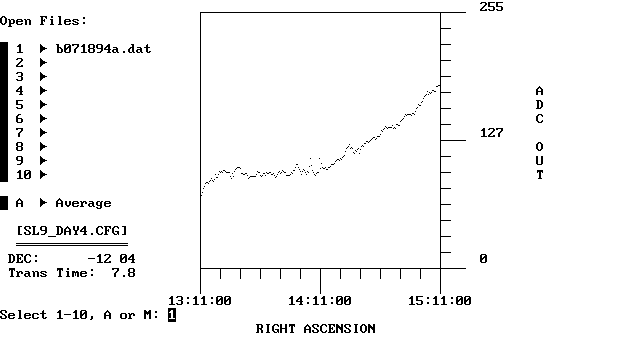
The recording (see Fig. 1 above) on this day shows the usual radio telescope baseline variation, but the two spikes near 14:11:00 are considerably "sharper" in shape, strong, and suggestive of a transient burst rather than the bell shaped pattern seen when a steady radio source (e.g. SNR) transits the beam. (Note: Prior to the SL9 impact, 10 nights of Jupiter scans were averaged to precisely fix the RA calibration. The actual RA is derived from the coarse RA in the data log file plus the above RA correction of 5 minutes. All RA's mentioned are actual). While observations from one radio telescope cannot prove that the measured radio bursts were caused by the Fragment L site, there is certainly a correlation. It is interesting to note that Jupiter was only in the telescope beam for 7.8 minutes out of every 24 hour period, and the largest fresh impact that could have been seen, due to impact timing, was in fact fragment L. No such bursts were seen on any other night during the encounter. Correlation with the next most recent fragments seems unlikely since at the time of the bursts Fragment K was already on its 2nd rotation and almost out of view on the limb, and Fragment H was 4 rotations old and behind Jupiter at that time. We would also like to report that a bell-shaped enhancement that matched the beam pattern occurred precisely as Jupiter crossed the beam at 1:27:00 UT on 7/19/94 (see fig. 2 below):
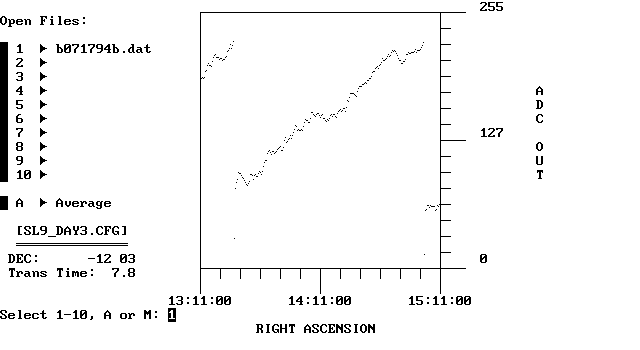
There were no fresh impact sites in the beam at that time, and no radio bursts were found. We would be very interested to hear from anyone who have any theories about this one! We did not find bell-shaped enhancements on any other night. It is our hope that this data may help others confirm their own findings. If you are aware of confirming data, please let us know!
BAMBI Home | What's New | Software | Jupiter Observations | SARA / Amateur Radio Astronomy